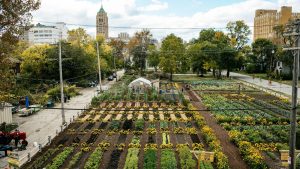Izzy Pippen
Food insecurity affects the daily lives of 38 million Americans and 18% of children in America are living in food insecure households (Ladner, 2011). Federal social programs and food banks designed to assist lower income individuals put food on the table help immensely in the short term but are not sustainable systems for reducing food deserts and long-term hunger. In post-industrial America the hunger crisis grows more and more each day. Children rely on breakfast and lunch provided by schools for their only steady meals, and parents sacrifice meals that they may have so that their children can eat. One of the main issues with government and non-profit programs is the lack of fresh high-quality food. Cast-off food, canned donations, and cheap junk food become the only types of food that are accessible (Ladner, 2011; Meenar, 2012). The high concentration of junk food and lack of accessible healthy options in low-income, urban and predominately minority areas increases the risk of nutrition related chronic diseases. I am from Indianapolis, Indiana, and the city has many areas where food deserts are prevalent. I worked directly with urban food systems when I worked for a non-profit called The Patachou Foundation that provides scratch made after school meals to school children in the most in need areas of the city. The foundation farms a small plot of land in the heart of the city that provides thousands of pounds of produce. My interest in and passion for sustainable urban food systems comes from first-hand experience.

Since the 1980’s, local food systems have been posed as a solution to the plethora of problems that have arisen from the commercialized and globalized modern food system. The urban farming movement advocates for a vast variety of causes including “social and economic issues such as health, nutrition and lifestyle, social justice, food security, community and economic development, to environmental issues such as land preservation, environmental conservation, and urban greening,” (Kremer, DeLiberty, & Schreuder, 2012). The urban farming movement is not simply about growing food, but the effects are diverse and widespread. Through the integrated wholistic system of learning, activism, and health urban farming became a catalyst for renewal in communities across the country.

The urban agriculture movement began as a response to the heavy industrialization, high prices, and inaccessibility of fresh produce in urban areas. In discussions on urban agriculture the food that is grown and made accessible is the predominant focus, but having an urban farm or garden also increases community interactions, adds more greenspaces to an area, decreases crime in the area, and fosters positive interactions between people from different walks of life (Ladner, 2011; Reynolds & Cohen, 2016).
One of my idols and inspirations is Devita Davison, founder of Food Lab Detroit and an incredible activist for food justice. Her 2017 TEDTalk on the growing quilt of urban farms across Detroit, Michigan shows the power of the African American community in Detroit and how their entrepreneurship and empathy has created a healthier community. Detroit, once the industrial capital of America has transformed its abandoned land, creating 1,500 farms and gardens across the city. Detroit is a

great example of urban farming for food security and sustainable development. Case studies in Detroit, MI show an increase in empowerment through urban agriculture in groups of people that are usually marginalized (Lawson & Miller, 2013). This sentiment is echoed in the South Bronx and Madison, WI (Lander, 2011; Reynolds & Cohen, 2016). Working in the dirt with another person doesn’t require a college degree or a shared language. The love and care that is put into community gardens creates a group of people who have a mutual wish for improvement in their community and are willing to enact change. Many of the groups that organized the community gardens also run non-profit and assistance programs (Cohen & Reynolds, 2016; Gu, Paul, Nixon & Duschack, 2012; Lander, 2011). Some groups work to help refugees find stability, some work to create safe spaces for women of color where they can learn safely, and some teach entrepreneurial skills to the youth of the community so that they have the tools that they need to be successful.
Some groups engage in activism, advocating for the groups that make up the community they created through their growing. Not engaging in the capitalist system that is oppressive to minority groups shows the self-sufficiency and the will to enact change that urban farmers have. Reynolds and Cohen describe this resistance, saying, “Producing one’s food in the city can be a strategy for personal and political resistance to many aspects of the conventional food system, from the monopolistic effects of corporate consolidation in US agriculture to the social and environmental ramifications of industrialized farming…” (2016). Guerilla gardening is a term that has been used to describe these urban farms because they work in cohesion with the landscape instead of against it, and it likens the farming to a type of warfare which I believe fits the power of the resistance.
Citations:
Davison, D. (2017. April). How urban agriculture is transforming Detroit [Video File]. Retrieved from https://www.ted.com/talks/devita_davison_how_urban_agriculture_is_transforming_detroit?language=en
Gu, S., Paul, K., Nixon, K., & Duschack, M. (2012). Urban farming and gardening taking roots in inner cities. Acta Horticulturae, (937), 1097–1107.
10.17660/actahortic.2012.937.137
Kremer, P., DeLiberty, T. L., & Schreuder, Y. (2012). Defining local food systems. In Gatrell, J.D., Ross, P.S., Reid, N. & Tamasy, C. (Eds.), Local food systems in old industrial regions: Concepts, spatial context, and local practices, (p.p. 71-93). Burlington, VT: Ashgate Publishing Company.
Lander, P. (2011). The urban food revolution: Changing the way we feed cities. British Columbia, Canada: New Society Publishers.
Lawson, L., & Miller, A. (2013). Community gardens and urban agriculture as antithesis to abandonment: Exploring a citizenship-land model. In M. Dewar & J. M. Thomas (Eds.), The City After Abandonment (p.p. 17-40). Philadelphia, PA: University of Pennsylvania Press.
Meenar, M, R. (2012). Feeding the hungry: Analysis of food insecurity in lower income urban communities. In Gatrell, J.D., Ross, P.S., Reid, N., & Tamasy, C. (Eds.), Local food systems in old industrial regions: Concepts, spatial context, and local practices (p.p. 71-93). Burlington, VT: Ashgate Publishing Company.